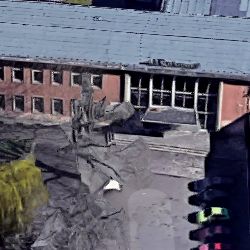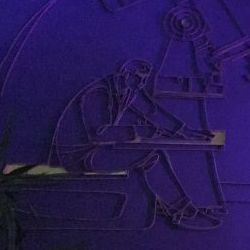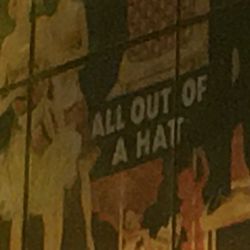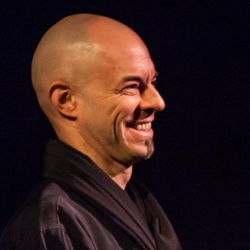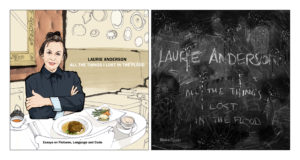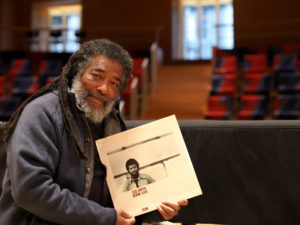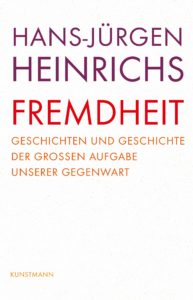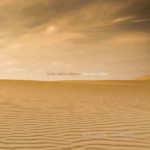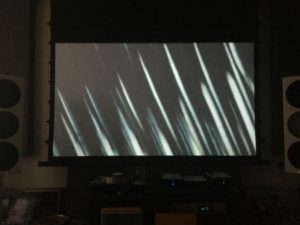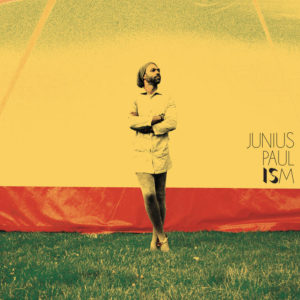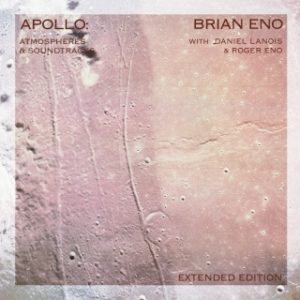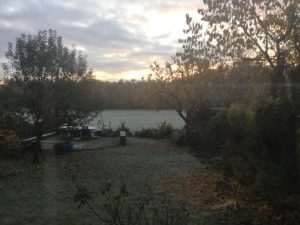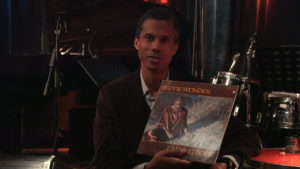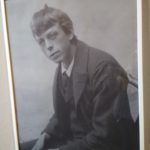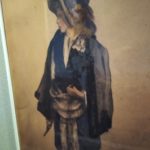Okay, denke ich mir, nehme ich den Ball, wo er schon geworfen wurde, doch einfach direkt mal auf und schreibe auch etwas anders als sonst über zehn favourite records des zu Ende gehenden Jahres. Tatsächlich wollte ich just vorgestern noch eine spontane Liste meiner persönlichen Lieblingsalben der 2010er hier kundtun, aber dann kam Michael mit seinem Beitrag zuvor, da schien es mir dann doch zu unpassend, eine „Best of 2010“-Liste zu posten.
Wie gestern schon im Kommentarfeld kundgetan, ist Mattiels zweites Album Satis Factory mein ungeschlagenes „Lieblingsalbum“ dieses Jahres. Ihr unbetiteltes Debütalbum 2018 fand ich schon ganz sympathisch, aber es hatte sich mir nicht so eingebrannt wie nun der Nachfolger. Erst als ich einen Narren an Satis Factory gefressen hatte, habe ich das Debüt dann doch noch als LP gekauft und seinen wunderbar zeitlosen Charme vollauf via old-fashioned vinyl in mein Wohnzimmer geholt. Satis Factory ist eine jeder seltenen Platten, die ich tatsächlich zu jeder beliebigen Tages- oder Nachtzeit und in jeder beliebigen Situation rauf und runter hören kann — und das, obwohl ich sonst gar nicht so auf diese etwas aufdringlich klugen Zitat-Rock&Pop-Alben stehe. Aber Mattiel hat einfach so eine mitreißende Energie und Fantasie, und es gelingt ihr, jedem Song eine gänzlich eigene Charakteristik zu verleihen und mit Humor und Power so zu verdichten, dass viele der 12 Nummern der LP unter drei Minuten kurz bleiben. Sogar eine eigentlich total cheesy Velvet-Underground-Hommage überzeugt. Und Keep The Change ist einfach der Popsong des Jahres, no question.
Wie gerne wäre ich zu ihrem Berlin-Konzert gegangen (ein heiterer Song der Platte heißt übrigens Berlin Weekend), aber dummerweise war ich ausgerechnet während ihrer Europatour selbst in der Heimat der US-Amerikanerin unterwegs.
(Mein persönlich) bestes Hip-Hop-Album 2019 ist das neue (offiziell dritte Album, doch darüber hinaus gab es noch vier fantasievolle „Mixtapes“ und fünf „EPs“, die z.T. kaum oder nicht kürzer als ein Album waren und die auch schon mal Gimme Shelter sampelten) Grey Area der Londonerin Little Simz, die ihren Künstlernamen als „Abkürzung“ ihres bürgerlichen nigerianischen Vornamens Simbiatu erhielt. Glücklicherweise konnte ich Little Simz bei einem tollen Berlin-Konzert erleben; ihre Energie und ihr Charisma sind bestechend. Da sie gerade mal 25 Jahre alt ist, dürfte von ihr noch viel Großes zu erwarten sein. Die 5-Sterne-Rezension im Independent titelte: „Rapper is light years ahead on new record with her dextrous flow and superb wordplay“ und kommentierte, ihr „bolder sound assisted by her childhood friend – the producer Inflo [Michael Kiwanuka’s Love & Hate]“ verbinde alles aus „jazz, funk and soul to punk and heavy rock, plus three carefully chosen features“. Genau, Michael Kiwanuka ist als Gast beim letzten Stück auch dabei.
Auch ein mitreißendes Konzert war Jamila Woods aus Chicago mit den Songs ihres zweiten Albums: „Each track on the album is named after a cultural icon who inspired Woods and shaped her identity as an artist and individual. Reveling in the legacies of artists, activists, writers, and musicians, Woods positions Legacy! Legacy! as a genuflection of gratitude. More so, the album ensures the cultural icons‘ impact is concertized within the contemporary moment. Woods, herself, a poet, singer, activist, and teacher, casts Legacy! Legacy! as a beacon for a type of self-empowerment informed by the predecessors who built and shaped culture.“ fasst Elisabeth Woronzoff zusammen.
„Die Sängerin, Poetin und Aktivistin aus Chicago setzt in 13 Songs und Songtiteln schwarzen Ikonen aus Musik, Kunst und Literatur ein Denkmal. Viele von diesen Ikonen nutzten ihre Kunst auch als gesellschaftliches Machtinstrument, andere gaben qua Existenz als erfolgreiche schwarze KünstlerInnen in einer von Weißen dominierten Gesellschaft schon ein politisches Statement ab: Miles Davis, Sun Ra, Eartha Kitt, der Schriftsteller und Sozialkritiker James Baldwin, der Künstler Jean-Michel Basquiat, die Poetin und Aktivistin Nikki Giovanni.Schon auf ihrem Debütalbum HEAVN von 2016 ging Jamila Woods Fragen nach der Rolle einer schwarzen Frau in einer weißen Gesellschaft nach, Fragen der Identität. LEGACY! LEGACY! ist der Beleg für schwarze Selbstermächtigung anhand von konkreten Fallbeispielen.“ (zitiert nach).
Auf der Webseite des Deutschlandfunk kann man ein Interview mit Jamila Woods nachhören und -lesen.
Immer wieder inspirierend sind die Techno-Doch-nicht-Techno-Alben beim Berliner Label Ostgut Ton, und besonders großartig ist (neben dem vielgelobten Konzeptalbum Atlantis von Efdemin) das Solodebüt von (Sam) Barker (bislang Teil des Duos Barker & Baumecker) aus England: „For anyone who has ever fantasized about dissolving into the dancefloor, Utility is about as close as it gets. On highlights like Models of Wellbeing (which nods to Rhythm & Sound’s aerated dub) and Utility, Barker puts minimalist techniques to opulent ends, conjuring ecstatic visions out of just a handful of sounds, and teasing vast shapes out of a silvery mist.“ meint Philip Sherburne, der auch Kim Gordon’s spätes Solodebüt mit vielen begeisterten Worten bedachte, die ich sehr treffend finde: „No Home Record is clearly interested in getting the hell away from the strictures of noise and indie rock as they’re conventionally understood. (…) Air BnB is a mammoth slab of bluesy, atonal rock, Earthquake is a shimmering drone-folk opus—but the most exciting moments are giddy with the sense of worlds colliding. Noise, techno, and post-punk; custom-tuned guitars and battered MPCs; 808s and overheated bass amps—multiple strains of underground music history pushing together like tectonic plates, building up extreme pressure under the surface.“ Es freute mich als langjähriger Fan von Sonic Youth sehr, dass Kim Gordon, mit einem stripped-down approach, endlich ihr großartiges eigenes Album herausgebracht hat, nachdem die bisherigen Post-Breakup-Alben der einzelnen SY-Bandmitglieder zwar gut, aber nicht allzu memorabel waren.
Kate Tempests drittes „echtes“ Album hatte mich anfangs nicht ganz so begeistert, da es (wohl auch dank Mitproduzent Rick Rubin) doch leiser und sehr viel reduzierter ausgefallen ist als die vorhergehenden CDs. Durch einen sehr erfreulichen Zufall landete ich im Oktober in Manhattan auf einer quasi-familiären Abendveranstaltung mit Kate Tempest; es war Teil einer in Privatwohnungen stattfindenden Reihe von Abenden mit ehemaligen Stipendiaten eines in Italien angesiedelten Künstlerhauses. An dem Abend war Benedicte Maurseth, eine norwegische Freundin von mir, die 2019 übrigens auch ein Soloalbum auf der Hardangergeige herausgebracht hat (das eigentlich für ECM aufgenommen worden war, aber aufgrund der langen Wartezeit dann doch nur in Norwegen veröffentlicht wurde) eingeladen, aus ihrem Buch über Knut Hamsum vorzulesen und ein paar Stücke zu spielen – und als zweite Stipendiaten des Abends war dann auch Kate Tempest da und performte die Hälfte ihres Albums (das sie als ein langes Gedicht vorstellte) a cappella in diesem Wohnzimmer einer New Yorker Künstlerin. So konnte ich ein paar Worte mit ihr wechseln, woraufhin sie mich und meine Frau zu ihrem Berlin-Konzert einlud. Da wären wir sonst aufgrund des hohen Eintrittspreises gar nicht hingegangen, doch es war ein berauschender Abend, 90 Minuten lang ohne Pause begeisterte die Wortkünstlerin die bestimmt 2000 Leute des vollen Saals (nur begleitet von einer Musikerin, die aus einem Arsenal von Instrumenten eine ungeheure Vielfalt an kraftvollen Soundideen herausholte), und nicht wenige waren von dieser Performance emotional zu Tränen bewegt, wie man hinterher auch noch aus dem Bekanntenkreis hörte. Und auch in der Presse gab es glühende Konzertbesprechungen wie die von Alexander Gumz: „Die Londoner Sängerin Kate Tempest brilliert im Huxleys mit einer Show zwischen Dichtung und Rap. (…) In ihren Texten geht es heute nicht mehr allein um die verstörte britische Jugend oder um als Zeitgenossen wiedergeborene antike Götter. Es geht um die ganze kaputte Gegenwart, um Kapitalismus, Brexit und Krieg. Es geht um Einsamkeit und um die Liebe, in ihren abhängig machenden und ihren befreienden Versionen.“ Ja, auch mir erlaubte dieser Abend, das Album erst in seiner Vielschichtigkeit und ungeheuren Kraft zu erfassen. The Book of Traps and Lessons ist eine großartige Verbindung aus persönlich-intimer Erzählung und Gegenwartsanalyse: „Like a beat reporter to the soul, the London native investigates with uncanny intuition the interior dialogues, self-destructive habits, and beautiful follies of human nature and spits them back at us in gut-punch moments of warning, recognition, and clarity.“ (Timothy Monger) Und nochmal Elisabeth Woronzoff: „Through her album, she inspires a call for consciousness that will certainly incite radical social and personal change.“
Und noch ein Konzert, das ich in diesem Herbst besuchte. Lange ausverkauft waren die beiden Abende der kalifornischen Songwriterin/Popmusikerin (Jillian) Banks in Neukölln, doch durch einen glücklichen Umstand konnte ich zwei Karten für insgesamt 20 Euro bei Ebay erwerben und damit für ca. ein Viertel des eigentlichen Eintrittspreises. Ich mochte schon ihre ersten beiden Alben, Goddess und The Altar, und mit ihrem dritten, simpel III genannt, machte sie einen energischen Schritt in Richtung der kantigeren, auch subtil experimentelleren, ähm, „Post-RnB-Elektro-Pop“-Richtung à la FKA twigs und Co. Nicht jeder Rezensent fand ihren Einsatz von Soundeffekten vorteilhaft – mich hingegen begeistern gerade diese Songs ihres Albums, die eben raue Noise-Effekte in die Popmusik bringen. Ich mag besonders diese Konfrontation von Energien, die daraus entsteht. auch zwischen Mainstream-Pop und Sound-Art, wie es eben auch die Platten von FKA Twigs bestechend zeigen. Peter Füssl der österreichischen Kulturzeitschrift sieht das anders: „Im Zentrum dieser hochemotionalen Songs steht Banks ausdrucksstarke und wandlungsfähige Stimme, die sie in Neo-Soul- oder Avant-R’n’B-Nähe rückt. (…) Banks könnte sich getrost mehr auf die Kraft ihres unter die Haut gehenden Gesanges verlassen, der nicht selten in einem Übermaß an elektronischen Effekten unterzugehen droht, wenn Bässe maßlos übersteuert und Auto-Tune-Orgien abgefeiert werden oder bis zum Anschlag verfremdet und verzerrt wird. III mag vielleicht einen zwiespältigen Eindruck hinterlassen, aber dass Banks vieles wagt und mitunter sicher auch Zukunftsträchtiges ausprobiert, statt sich auf biedere Charts-Tauglichkeit zu kaprizieren, verdient jedenfalls Respekt.“
Noch noisig-elektronischer ist da die beim famosen Noise/Industrial/Techno/Elektro-Label Avian erschienene neue Platte der Dänin SØS Gunver Ryberg, Entangled, beste Klangkunst in der Tradition des großen Meisters Mika Vainio (vgl. auch Franck Vigroux‘ Album Totem). „Experimental techno at its most forceful and refined,“ sagt Max Graef Lakin:
Sound installations, theatre commissions, video game soundtracks, research and field-recording trips to South Korea and Svalbard—it’s far from the biography of your average dance music producer. She’s arrived at techno by a very different trajectory to most artists, and it shows. (…) Throughout her career, Ryberg has explored music at its most physical. As she explained to The Quietus last year, „I really seek out those frequencies that go into your body and resonate.“ You can hear this approach clearly on noise releases like „AFTRYK“ and the intense percussive workouts on last year’s SOLFALD, both designed to be heard at bone-rattling volumes. Entangled might feel at points like a step back from these extremes, but it also shows that Ryberg doesn’t need to rely on volume and bass vibration to elicit physical response. At different points Entangled manages to be hair-raising, punishing and caressing. It’s an immersive piece of music from one of contemporary techno’s most adventurous producers.
Und dann, wie schon angedeutet, FKA twigs´ zweites Album, Magdalene. Die radikalen Soundideen ihrer superben letzten Platte M3LL155X, hat sie (erstmal) hinter sich gelassen, zugunsten eines feingliedrigeren, doch nicht weniger sensiblen Popgestus, den Pitchfork nicht unpassend mit einer zeitgenössischen Kate Bush vergleicht:
„With limitlessly innovative songwriting and production, the cinema of twigs’ music has never been more affecting. MAGDALENE is not just on the vanguard of pop, it’s in a breathtaking class of its own. (…) MAGDALENE is visceral and direct, but despite featuring a trunk-thumping Future collaboration (“holy terrain”), this is not a play to make pop music in the charts-humping sense. It’s a document of twigs’ marked achievements in songwriting and musicality as she elucidates her melodies without sacrificing her viewpoint. “sad day,” one of MAGDALENE’s most astonishing tracks, finds twigs properly genuflecting at the altar of Kate Bush, clearly having learned from her ability to translate inner sanctum into cinematic, Shelleyan alt-pop.“
Vieles könnte auch noch gesagt werden über die reiche Minimal Music von John Luther Adams, 2019 mit dem Epos Becoming Desert zu hören: „Inspired by the desert landscapes of his new Mexico home, the Pulitzer prize-winner takes us on an journey from the joyous to the apocalyptic“, so die 5-star review im Guardian. Bei YouTube gibt es ein kleines Video, in dem der Komponist recht unwiderstehlich zum Erleben seines neuen Werks einlädt. Auch schön ist dieses Interview/Portrait im Guardian aus dem Jahr 2015. Und hier ein lesenswerter Bericht des Komponisten selbst, in dem er von seinem Leben in Landschaften zwischen Alaska (wo er 40 Jahre lang lebte), Mexico und New York erzählt.
Gianna Nannini hat mit knapp Mitte 60, nachdem ihre Alben der letzten mindestens zehn Jahre vorrangig einem recht gemütlichen Schema von sympathischem Streicher-Rock mit oftmals nicht direkt zwingenden Keyboard-Popsounds folgten, für ihre neue Platte etwas anders gemacht: Sie ging ohne ihre gewohnten Musiker und ohne ihren langjährigen Produzenten und Arrangeur ins Studio nach Nashville und nahm das erfrischend kompakte Album La Differenza als „Live Studio Production“ mit dortigen Sessionmusikern – und vor allem ohne Keyboards und dergleichen (naja, fast ohne) – auf. Hat Signora Nannini ihre Rolle als rockige „Janis Joplin Italiens“ in ihren Sechzigern auch längst hinter sich gelassen und wird kaum mehr eine Scheibe mehr wie zu Conny-Plank-Zeiten oder wie ihre kraftstrotzenden großen Livealben Tutto Live (1985) und Giannissima (1991) vorlegen: La Differenza ist ihr schönstes, erdigstes und souveränstes Album seit langem geworden. Vielleicht legt die wandelbare Italierin, in ihrem fünften Jahrzehnt als Musikerin am Ende noch ein starkes Spätwerk hin…
Und abschließend noch kurz zu den beiden tollen Alben, die das von mir seit bestimmt 20 Jahren hochgeschätzte Label Raster-Media für Avantgarde/Sound-Art/Elektronische Musik/ Konzeptkunst 2019 veröffentlichte: Die Japanerin Kyoka veröffentlichte bei Raster (damals noch Raster-Noton, dem Zusammenschluss mit Carsten Nicolais jetzt wieder unabhängigem Noton-Label) vor wenigen Jahren das exzellente Album is (is superpowered) (späte, aber nachdrückliche Empfehlung!). Nun, in Zusammenarbeit mit dem irischen Produzenten Ian McDonnell alias Eomac in den schwedischen, elektronischen EMS-Studios entstanden, gibt es das Album Söder Mälarstrand, das die beiden unter dem Alias Lena Andersson veröffentlichten:
Es ist ein intuitives, dialogisches Arbeiten der beiden: Kyoka liefert das Basismaterial, Field Recordings, Mikrosamples von menschlichen Stimme und Eomac baut die Beats darum. SÖDER MÄLARSTRAND ist eine weitere Versuchsanordnung, die dem Thema Techno gewidmet ist, ohne selbst hundertprozentig Techno zu sein. Es geht auch hier um Repetition und leichte Veränderungen, aber auch um Dekonstruktion und Richtungswechsel. Obwohl die Musik auf dem Album – irgendwo zwischen Glitch und Ambient – abstrakt und experimentell bleibt, weil die Beats ins Stolpern geraten, sich verschieben oder sich gegenseitig überlagern, entwickeln manche Tracks eine eigentümliche Funkyness, sodass wir dann doch wieder von Techno reden wollen. (Albert Koch, ME)
Und eine echte Entdeckung: Grischa Lichtenbergers re: phgrp. Lichtenberger nutzte Material von Philipp Groppers Jazzalbum Consequences (Saxofon, Bass, Piano und Schlagzeug), 2019 auf WhyPlayJazz veröffentlicht, und konstruierte daraus eine ganz neue, andere, elektroakustisch-experimentelle Musik, die sich zwischen den Stilen befindet:
In his unsound jazz, this innovative artist creates a brand new genre out of twisted notes. Electronic no longer cares to be separate from all acoustic – it simply swallows and then envelopes it all. Micro clicks on looped and mutilated percussive beats are stitched into synthetic auditory scenes. Organic instrumental howls are drowned in modulated sine waves, which are controlled with knobs and wires of machines. The piano and the sax are torn apart into the grains of sprinkled points across de-ranged dynamics. (Headphone Commute)
Mal schauen… ein paar Alben, die auch Erwähnung wert sind, schiebe ich dann demnächst noch hinterher. Dies erstmal als erster Versuch eines Jahresrückblicks, der im besten Fall auch noch andere inspiriert, etwas aus dem zu Ende gehenden Jahr aufzusuchen.
